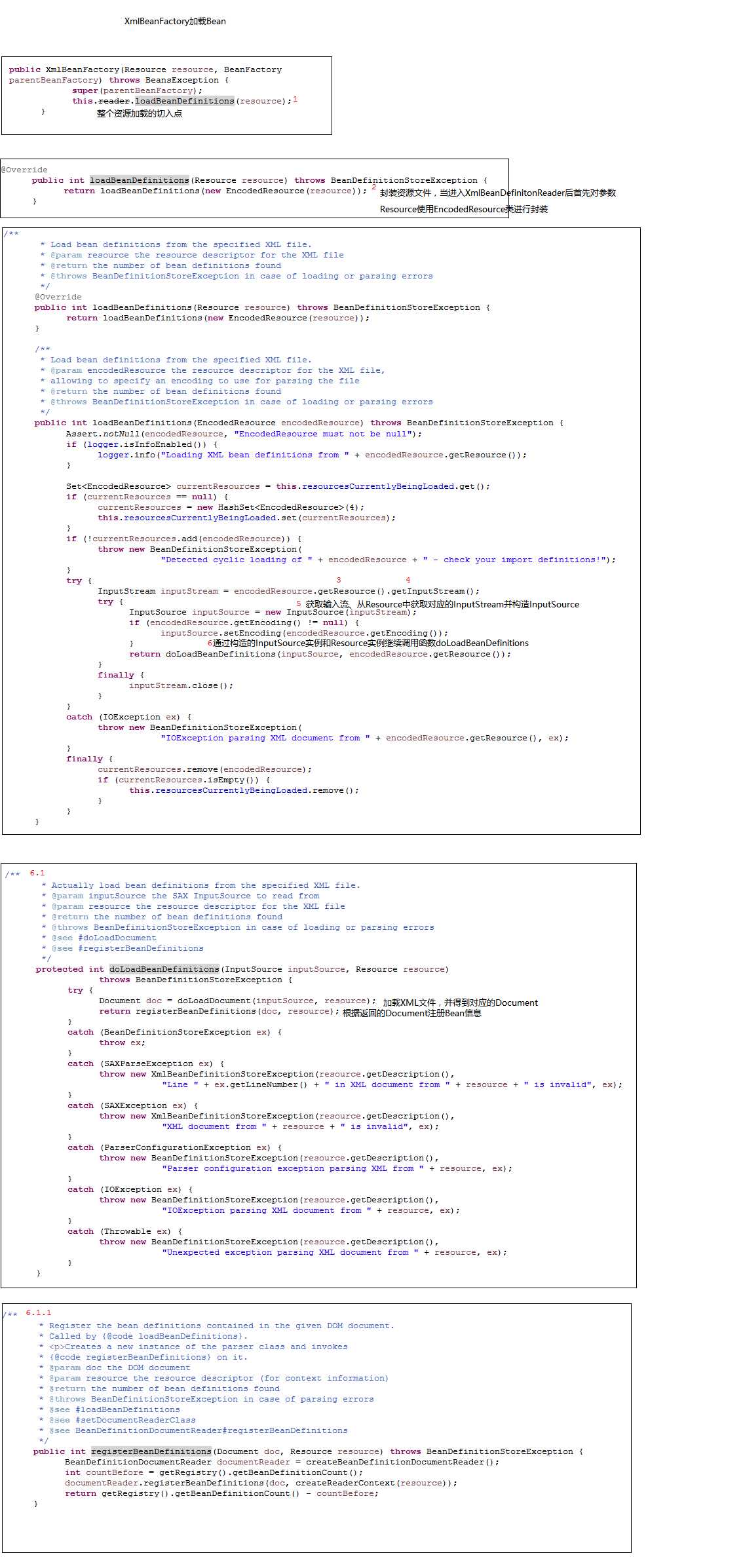【Spring源码深度解析学习系列】容器的基础XmlBeanFactory(二)
一、配置文件封装
Spring的配置文件读取是通过ClassPathResource进行封装的,如new ClassPathResource("test.xml"),那么ClassPathResource完成的功能是什么呢?
在java中,将不同来源的资源抽象成URL,通过注册不同的handler(URLStreamHandler)来处理不同来源的资源的读取逻辑,一般handler的类型使用不同前缀(协议,Protocol)来识别,如:file: http: jar: 等,然而URL没有默认定义相对Classpath或ServletContext等资源的handler,虽然可以注册自己的URLStreamHandler来解析特定的URL前缀(协议),比如“classpath:”,这个需要了解URL的实现机制,而且url也没有提供一些基本的方法,如检查当前资源是否存在、检查当前资源是否可读等方法。因而Spring对其内部使用到的资源实现了自己的抽象结构:Resource接口来封装底层资源:
public interface InputStreamSource {
/**
* Return an {@link InputStream} for the content of an underlying resource.
* <p>It is expected that each call creates a <i>fresh</i> stream.
* <p>This requirement is particularly important when you consider an API such
* as JavaMail, which needs to be able to read the stream multiple times when
* creating mail attachments. For such a use case, it is <i>required</i>
* that each {@code getInputStream()} call returns a fresh stream.
InputStream getInputStream() throws IOException;
}
public interface Resource extends InputStreamSource {
/**
* Determine whether this resource actually exists in physical form.
* <p>This method performs a definitive existence check, whereas the
* existence of a {@code Resource} handle only guarantees a valid
* descriptor handle.
*/
boolean exists();
/**
* Indicate whether the contents of this resource can be read via
* {@link #getInputStream()}.
* <p>Will be {@code true} for typical resource descriptors;
* note that actual content reading may still fail when attempted.
* However, a value of {@code false} is a definitive indication
* that the resource content cannot be read.
* @see #getInputStream()
*/
boolean isReadable();
/**
* Indicate whether this resource represents a handle with an open stream.
* If {@code true}, the InputStream cannot be read multiple times,
* and must be read and closed to avoid resource leaks.
* <p>Will be {@code false} for typical resource descriptors.
*/
boolean isOpen();
/**
* Return a URL handle for this resource.
* @throws IOException if the resource cannot be resolved as URL,
* i.e. if the resource is not available as descriptor
*/
URL getURL() throws IOException;
/**
* Return a URI handle for this resource.
* @throws IOException if the resource cannot be resolved as URI,
* i.e. if the resource is not available as descriptor
* @since 2.5
*/
URI getURI() throws IOException;
/**
* Return a File handle for this resource.
* @throws java.io.FileNotFoundException if the resource cannot be resolved as
* absolute file path, i.e. if the resource is not available in a file system
* @throws IOException in case of general resolution/reading failures
* @see #getInputStream()
*/
File getFile() throws IOException;
/**
* Determine the content length for this resource.
* @throws IOException if the resource cannot be resolved
* (in the file system or as some other known physical resource type)
*/
long contentLength() throws IOException;
/**
* Determine the last-modified timestamp for this resource.
* @throws IOException if the resource cannot be resolved
* (in the file system or as some other known physical resource type)
*/
long lastModified() throws IOException;
/**
* Create a resource relative to this resource.
* @param relativePath the relative path (relative to this resource)
* @return the resource handle for the relative resource
* @throws IOException if the relative resource cannot be determined
*/
Resource createRelative(String relativePath) throws IOException;
/**
* Determine a filename for this resource, i.e. typically the last
* part of the path: for example, "myfile.txt".
* <p>Returns {@code null} if this type of resource does not
* have a filename.
*/
String getFilename();
/**
* Return a description for this resource,
* to be used for error output when working with the resource.
* <p>Implementations are also encouraged to return this value
* from their {@code toString} method.
* @see Object#toString()
*/
String getDescription();
}
InputStreamSource封装任何能返回InputStream的类,比如File、Classpath下的资源和 Byte Array对象。它只有一个方法定义:getInputStream(),该方法返回一个新的InputStream对象。
Resource接口抽象了所有Spring内部使用到的底层资源:File、URL、Classpath等,首先、它定义了3个判断当前资源状态的方法:存在性(exists)、可读性(isReaddable)、是否处于打开状态(isOpen)另外Resource接口还提供了不同资源到URL、URI、File类型的转换,以及获取lastModified属性、文件名(不带路径信息的文件名,getFilename())的方法。为了便于操作,Resource还提供了基于当前资源创建一个相对资源的犯法:createRelative()。在错误处理中需要详细打印出错的资源文件,因而Resource还提供了getDescription()方法用于在错误处理中的打印信息。
对不同来源的资源文件都有相应的Resource实现:文件(FileSystemResource)、Classpath资源(ClassPathResource)、URL资源(UrlResource)、InputStream资源(InputStreamResource)、Byte数组(ByteArrayResource)等。
加载资源文件的代码:
Resource resource = new ClassPathResource("beanFactoryTest.xml");
InputStream inputStream = resource.getInputStream();
ClassPathResource的实现:
public InputStream getInputStream() throws IOException {
InputStream is;
if (this.clazz != null) {
is = this.clazz.getResourceAsStream(this.path);
}
else if (this.classLoader != null) {
is = this.classLoader.getResourceAsStream(this.path);
}
else {
is = ClassLoader.getSystemResourceAsStream(this.path);
}
if (is == null) {
throw new FileNotFoundException(getDescription() + " cannot be opened because it does not exist");
}
return is;
}
FileInputStream的实现:
public InputStream getInputStream() throws IOException {
return new FileInputStream(this.file);
}
当通过Resource相关类完成了对配置文件进行封装后配置文件的读取工作就全权交给XmlBeanDefinitonReader来处理了。
XmlBeanFactory的初始化有若干方法,Spring中提供了很多的构造函数,以下为使用Resource实例作为构造函数参数的办法。
public XmlBeanFactory(Resource resource) throws BeansException {
//调用XmlBeanFactory(Resource,BeanFactory)构造方法
this(resource, null);
}
public XmlBeanFactory(Resource resource, BeanFactory parentBeanFactory) throws BeansException {
super(parentBeanFactory);
this.reader.loadBeanDefinitions(resource);
}

public void ignoreDependencyInterface(Class<?> ifc) {
this.ignoredDependencyInterfaces.add(ifc);
}
ignoreDependencyInterface的主要功能是忽略给定接口的自动装配功能。这样做的目的是什么呢?举例来说,当A中有属性B,那么当Spring在获取A的Bean的时候如果其属性B还没有初始化,那么Spring会自动初始化B,这也是Spring中提供的一个重要特性。但是某些情况下,B不会被初始化,其中的一种情况就是B实现了BeanNameAware接口,Spring中是这样介绍的:自动装配时忽略给定的依赖接口,典型应用是通过其他方式解析Application上下文注册依赖,类似于BeanFactory通过BeanFactoryAware进行注册或者ApplicationContext通过ApplicationContextAware进行注入。
二、加载Bean

【Spring源码深度解析学习系列】容器的基础XmlBeanFactory(二)的更多相关文章
- 【Spring源码深度解析学习系列】Bean的加载(六)
Bean的加载所涉及到的大致步骤: 1)转换对应beanName 为什么需要转换beanName呢?因为传入的参数可能是别名,也可能是FactoryBean,所以需要一系列的解析,这些解析内容包括如下 ...
- 【Spring源码深度解析学习系列】复杂标签属性解析(四)
一.创建用于属性承载的BeanDefinition BeanDefiniton是一个接口,在Spring中存在三种实现:RootBeanDefinition.ChildBeanDefinition.G ...
- 【Spring源码深度解析学习系列】默认标签解析(三)
Spring的标签包括默认标签和自定义标签两种 默认标签的解析方法: ###DefaultBeanDefinitionDocumentReader.java### private void parse ...
- 【Spring源码深度解析学习系列】核心类介绍(一)
一.DefaultListableBeanFactory 首先看一下结构 由图可知XmlBeanFactory继承自DefaultListableBeanFactory,而DefaultListabl ...
- 【Spring源码深度解析学习系列】注册解析的BeanDefinition(五)
对于配置文件,解析和装饰完成之后,对于得到的beanDefinition已经可以满足后续的使用要求了,还剩下注册,也就是processBeanDefinition函数中的BeanDefinitionR ...
- spring源码深度解析— IOC 之 容器的基本实现
概述 上一篇我们搭建完Spring源码阅读环境,spring源码深度解析—Spring的整体架构和环境搭建 这篇我们开始真正的阅读Spring的源码,分析spring的源码之前我们先来简单回顾下spr ...
- Spring源码分析(四)容器的基础XmlBeanFactory
摘要:本文结合<Spring源码深度解析>来分析Spring 5.0.6版本的源代码.若有描述错误之处,欢迎指正. 经过Spring源码分析(二)容器基本用法和Spring源码分析(三)容 ...
- spring源码深度解析— IOC 之 开启 bean 的加载
概述 前面我们已经分析了spring对于xml配置文件的解析,将分析的信息组装成 BeanDefinition,并将其保存注册到相应的 BeanDefinitionRegistry 中.至此,Spri ...
- spring源码深度解析— IOC 之 默认标签解析(上)
概述 接前两篇文章 spring源码深度解析—Spring的整体架构和环境搭建 和 spring源码深度解析— IOC 之 容器的基本实现 本文主要研究Spring标签的解析,Spring的标签 ...
随机推荐
- ubuntu14.04 64位 安装JDK1.7
ubuntu14.04 64位 安装JDK1.7 1 新建文件夹 youhaidong@youhaidong:~$ sudo mkdir /usr/lib/jvm 2 解压文件 youhaidong@ ...
- Struts2(六) 用Struts完成客户列表显示
Struts完成客户列表显示 所用的基础知识 在之前的随笔中已经讲过.这篇是介绍如何使用Struts 完成客户列表显示 . 下面是 完成的代码执行逻辑图: 抽取项目部分代码 相信大家认真看一遍就明 ...
- Python爬虫之模拟登录微信wechat
不知何时,微信已经成为我们不可缺少的一部分了,我们的社交圈.关注的新闻或是公众号.还有个人信息或是隐私都被绑定在了一起.既然它这么重要,如果我们可以利用爬虫模拟登录,是不是就意味着我们可以获取这些信息 ...
- mysql下如何删除本节点下的所有子节点小记
在开发过程中,经常会遇到树形结构的数据,在删除某个节点时候其所有的子节点都要被删除,可以使用如下方法: 1.添加记录该节点所有父节点的ID的字段(parent_ids),并用逗号隔开(一定是逗号),如 ...
- 【HDU1754】I hate it!
题面 很多学校流行一种比较的习惯.老师们很喜欢询问,从某某到某某当中,分数最高的是多少. 这让很多学生很反感. 不管你喜不喜欢,现在需要你做的是,就是按照老师的要求,写一个程序,模拟老师的询问.当然, ...
- [HDU5663]Hillan and the girl
题面戳我(题面很鬼畜建议阅读一下) 题意:给出n,m,求 \[\sum_{i=1}^{n}\sum_{j=1}^{m}[gcd(i,j)\mbox{不是完全平方数}]\] 多组数据,\(n,m\le1 ...
- 关于 CI框架访问数据库类提示Call to undefined function mysqli_init() 问题解决
我上次实践发现,安装在Win10 WampServer3.0.4集成环境,不仅打不开phpmyadmin会报错就算了,而且报错后又没提示那么解决,同时你打开php扩展配置发现,WampServer系统 ...
- Spring AOP梳理
一.Srping AOP AOP(Aspect Oriented Programming)解释为面向切面编程,何为切面,用刀把一块面包切成两半,刀切下去形成的面就叫切面,那么面向切面的就是形成切面的这 ...
- handsontable 属性汇总
常规属性: 1.固定行列位置 fixedRowsTop:行数 //固定顶部多少行不能垂直滚动 fixedColumnsLeft:列数 //固定左侧多少列不能水平滚动 2.拖拽行头或列头改变行或列的大小 ...
- Linux shell 脚本(一)
一.初识脚本 shell:一类介于系统内核与用户之间的解释程序.脚本:一类使用特定语言,按预设顺序执行的文件批处理.宏.解释型程序创建shell脚本:理清任务过程--整理执行语句--完善文件结构1.任 ...
